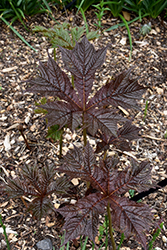It's all about ...
plants

Bloody Wheels Rodgersia
Rodgersia podophylla 'Bloody Wheels'
Plant Height: 30 inches
Flower Height: 4 feet
Spacing: 30 inches
Sunlight:
![]()
![]()
Hardiness Zone: 5a
Description:
This selection presents stunning foliage with sharply serrated edges, that emerges red, deepens to copper-bronze, becoming dark green by midsummer; lacy panicles of white flowers held high over the coarse foliage, providing beautiful contrast
Ornamental Features
Bloody Wheels Rodgersia features airy plumes of white flowers rising above the foliage from early to mid summer. The flowers are excellent for cutting. Its attractive large serrated lobed palmate leaves emerge dark red in spring, turning dark green in colour with showy coppery-bronze variegation and tinges of brick red. As an added bonus, the foliage turns a gorgeous coppery-bronze in the fall. The red stems are very colorful and add to the overall interest of the plant.
Landscape Attributes
Bloody Wheels Rodgersia is an herbaceous perennial with tall flower stalks held atop a low mound of foliage. Its wonderfully bold, coarse texture can be very effective in a balanced garden composition.
This is a relatively low maintenance plant, and should be cut back in late fall in preparation for winter. Deer don't particularly care for this plant and will usually leave it alone in favor of tastier treats. It has no significant negative characteristics.
Bloody Wheels Rodgersia is recommended for the following landscape applications;
- Mass Planting
- General Garden Use
- Groundcover
- Bog Gardens
Planting & Growing
Bloody Wheels Rodgersia will grow to be about 30 inches tall at maturity extending to 4 feet tall with the flowers, with a spread of 3 feet. When grown in masses or used as a bedding plant, individual plants should be spaced approximately 30 inches apart. It grows at a slow rate, and under ideal conditions can be expected to live for approximately 10 years. As an herbaceous perennial, this plant will usually die back to the crown each winter, and will regrow from the base each spring. Be careful not to disturb the crown in late winter when it may not be readily seen!
This plant does best in partial shade to shade. It prefers to grow in moist to wet soil, and will even tolerate some standing water. This plant should not require much in the way of fertilizing once established, although it may appreciate a shot of general-purpose fertilizer from time to time early in the growing season. It is not particular as to soil pH, but grows best in rich soils. It is somewhat tolerant of urban pollution. Consider applying a thick mulch around the root zone over the growing season to conserve soil moisture. This is a selected variety of a species not originally from North America. It can be propagated by division; however, as a cultivated variety, be aware that it may be subject to certain restrictions or prohibitions on propagation.
This plant is not reliably hardy in our region, and certain restrictions may apply; contact the store for more information.
